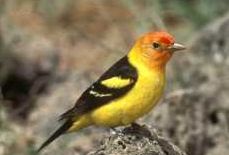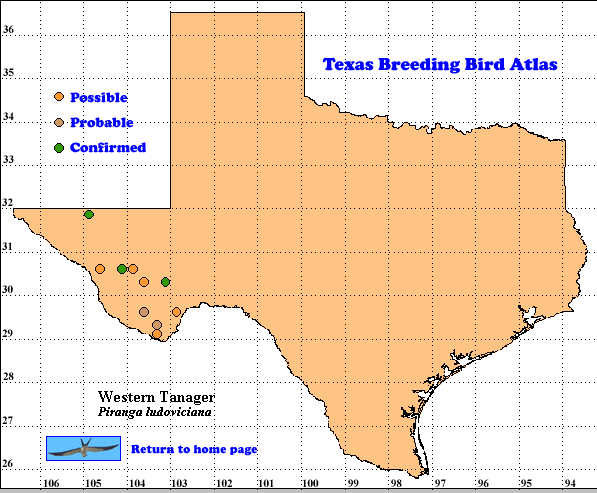Tanagers are one of the most colorful groups of birds in the Western Hemisphere and the Western Tanager male is even more striking than the other three species which breed widely in North America. Recent studies have show its closest relative is not one of these, but the Flame-colored Tanager (P. bidentata; Burns 1998). This species is accidental in Texas, but in Arizona it has hybridized with Western Tanagers (Hudon 1999).
DISTRIBUTION. During the 1987-1992 field work seasons of the TBBA project, observers found all breeding evidence for Western Tanager in the Trans-Pecos region. In the Guadalupe Mountains (latilomg-quad 31104-H7) there were one confirmed, 7 probable and one possible breeding records. Around the Davis Mountains another confirmed record was obtained in 30104-F2 with a probable in quad F1 and possibles in F2 and E6. In latilong 29103 a confirmed record was found in D2 and possibles in C6 and D8. In and around Big Bend National Park probable evidence was obtained in 29103-C3 and F6 and possible evidence in B3 and another possible in 29102-F8. Breeding has been reported in the Guadalupe Mountains and summer residency in the Chisos and Davis Mountains (Oberholser 1974).
From Texas the breeding range extends west at higher elevations to north Baja California and north along the Pacific Coast to southeast Alaska and east to eastern Saskatchewan. (Hudon 1999). Western Tanagers winter from Baja California Sur and central Mexico south to west Panama (Howell and Webb 1995).
SEASONAL OCCURRENCE. Most Western Tanagers arrive in spring from early April to late May, when they are uncommon to common in the Trans-Pecos and High Plains regions (see the region map in Lockwood and Freeman [2004]). These tanagers probably breed in Texas from late April to mid-August, and most southbound migrants are present from late August to early November (Oberholser 1974, Lockwood and Freeman 2004). In Arizona, atlasers found breeding evidence from early May to early August (Moors and Corman 2005). In Colorado, breeding dates ranged from nest building on May 21 to fledged young on August 9 (Roth and Kingery 1998).
BREEDING HABITAT. Western Tanagers have been found breeding in Texas at about 2400 m (8000 ft) in conifers (Oberholser 1974). In Arizona 77% of breeding evidence was found in habitats containing ponderosa pine, mixed with such species as Douglas fir, Gambel’s oak, pinyon pine and juniper. Ten percent were found in deciduous riparian habitats (Moors and Corman 2005). In Colorado 64% of graphed breeding reports came from coniferous forests and 27% from deciduous habitats (often aspen: Roth and Kingery 1998).
The nest is usually saddled in a fork of a horizontal branch of a tree at the edge of an opening. The nest is usually 2.5-5 m (8-17 ft) above ground. The female builds the loosely woven, flat bowl with a relatively small cup, of twigs, coarse grasses, rootlets, bark stripes, pine needles and mosses. She lines it with materials such as fine rootlets and hair.
The female usually lays 3-4 smooth, blue to bluish green eggs, sparsely speckled or spotted with shades of brown. She incubates the eggs for about 13 days, and is sometimes so reluctant to flush that she can be picked off the nest by hand. Parasitism by Brown-headed Cowbirds (Molothrus ater) is rare (Harrison 1979, Hudon 1999).
STATUS. The TBBA map is similar to the distribution of summer and breeding symbols on Oberholser’s (1974) map. This tanager is uncommon to locally common in summer in the Davis and Guadalupe mountains (Lockwood and Freeman 2004). The North American Breeding Bird Survey does not sample Western Tanagers in Texas, but data from 663 routes in the United States and Canada provide a statistically significant population trend of +1.5% per year for the period 1980-2005 (Sauer et al. 2005). The future of the limited population in the Trans-Pecos mountains will probably be determined by future habitat conditions there. Text by Robert C. Tweit (2007)
Harrison, H. H. 1979. A field guide to western birds’ nests. Houghton Mifflin, Boston, MA.
Lockwood, M. W. and B. Freeman. 2004. The TOS handbook of Texas birds. Texas A&M University Press, College Station.
Oberholser, H. C. 1974. The bird life of Texas. University of Texas Press, Austin.
Sauer, J. R., J. E. Hines, and J. Fallon. 2005. The North American Breeding Bird Survey, results and analysis 1966-2005. Version 6.2 2006. USGS Patuxent Wildlife Research Center, Laurel MD < http://www.mbr-pwrc.usgs.gov/bbs>

